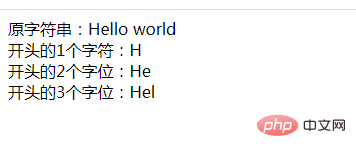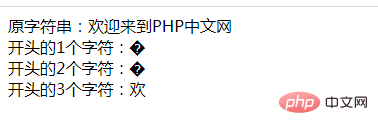How to query what string starts with in php
Two implementation methods: 1. Use the substr() function to query the header character. You only need to set the second parameter of the function to 0 and the third parameter to N to get the beginning of the string. N characters, syntax "substr(string,0,N)". 2. Use the mb_substr() function to query the header characters. You only need to set the second parameter of the function to 0 and the third parameter to N to get the N characters at the beginning of the string. The syntax is "mb_substr(string, 0,N,Character encoding)".

The operating environment of this tutorial: Windows 7 system, PHP version 8.1, DELL G3 computer
What does the php query string start with, is the query What are the characters (substring) at the head of the string. We can do this by getting the header characters.
Method 1: Use substr() to query (get) the header characters
The substr() function can intercept characters of a certain length from the specified position of the string.
substr(string,start,length)
| Parameters | Description |
|---|---|
| string | Required . Specifies a part of the string to be returned. |
| start | Required. Specifies where in the string to begin.
|
| length | Optional. Specifies the length of the string to be returned. The default is until the end of the string.
|
Just set the second parameter of the function to 0 and the third parameter to N to get the first N characters of the string.
<?php header('content-type:text/html;charset=utf-8'); $str="Hello world"; echo "原字符串:".$str."<br>"; echo "开头的1个字符:".substr($str,0,1)."<br>"; echo "开头的2个字符:".substr($str,0,2)."<br>"; echo "开头的3个字符:".substr($str,0,3)."<br>"; ?>

Note: The substr() function has no problem processing English, but in development we often deal with Chinese There are many characters. Although the substr() function can also handle Chinese, it is not perfect.
<?php header('content-type:text/html;charset=utf-8'); $str="欢迎来到PHP中文网"; echo "原字符串:".$str."<br>"; echo "开头的1个字符:".substr($str,0,1)."<br>"; echo "开头的2个字符:".substr($str,0,2)."<br>"; echo "开头的3个字符:".substr($str,0,3)."<br>"; ?>

In the substr() function, a GB2312 encoded Chinese character occupies two characters in length, and a UTF-8 encoded Chinese characters are three characters long.
So how to intercept Chinese characters? You can use the mb_substr() function.
Method 2: Use the mb_substr() function to query (get) the header characters
The mb_substr() function can intercept a specified part from a string, and substr () function is different in that, The mb_substr() function is not only valid for English characters, but also for Chinese characters.
mb_substr(string,start,length,encoding)
string, start, length: have the same effect as the three parameters of the substr() function, please refer to them.
encoding: is an optional parameter used to set the character encoding; if omitted, the internal character encoding is used.
You only need to set the second parameter of the function to 0 and the third parameter to N to get the first N characters of the string.
<?php header('content-type:text/html;charset=utf-8'); $str="欢迎来到PHP中文网"; echo "原字符串:".$str."<br>"; echo "开头的1个字符:".mb_substr($str,0,1,"utf- 8")."<br>"; echo "开头的2个字符:".mb_substr($str,0,2,"utf- 8")."<br>"; ?>

Recommended learning: "PHP Video Tutorial"
The above is the detailed content of How to query what string starts with in php. For more information, please follow other related articles on the PHP Chinese website!

Hot AI Tools

Undresser.AI Undress
AI-powered app for creating realistic nude photos

AI Clothes Remover
Online AI tool for removing clothes from photos.

Undress AI Tool
Undress images for free

Clothoff.io
AI clothes remover

Video Face Swap
Swap faces in any video effortlessly with our completely free AI face swap tool!

Hot Article

Hot Tools

Notepad++7.3.1
Easy-to-use and free code editor

SublimeText3 Chinese version
Chinese version, very easy to use

Zend Studio 13.0.1
Powerful PHP integrated development environment

Dreamweaver CS6
Visual web development tools

SublimeText3 Mac version
God-level code editing software (SublimeText3)

Hot Topics
 1387
1387
 52
52
 PHP 8.4 Installation and Upgrade guide for Ubuntu and Debian
Dec 24, 2024 pm 04:42 PM
PHP 8.4 Installation and Upgrade guide for Ubuntu and Debian
Dec 24, 2024 pm 04:42 PM
PHP 8.4 brings several new features, security improvements, and performance improvements with healthy amounts of feature deprecations and removals. This guide explains how to install PHP 8.4 or upgrade to PHP 8.4 on Ubuntu, Debian, or their derivati
 7 PHP Functions I Regret I Didn't Know Before
Nov 13, 2024 am 09:42 AM
7 PHP Functions I Regret I Didn't Know Before
Nov 13, 2024 am 09:42 AM
If you are an experienced PHP developer, you might have the feeling that you’ve been there and done that already.You have developed a significant number of applications, debugged millions of lines of code, and tweaked a bunch of scripts to achieve op
 How To Set Up Visual Studio Code (VS Code) for PHP Development
Dec 20, 2024 am 11:31 AM
How To Set Up Visual Studio Code (VS Code) for PHP Development
Dec 20, 2024 am 11:31 AM
Visual Studio Code, also known as VS Code, is a free source code editor — or integrated development environment (IDE) — available for all major operating systems. With a large collection of extensions for many programming languages, VS Code can be c
 Explain JSON Web Tokens (JWT) and their use case in PHP APIs.
Apr 05, 2025 am 12:04 AM
Explain JSON Web Tokens (JWT) and their use case in PHP APIs.
Apr 05, 2025 am 12:04 AM
JWT is an open standard based on JSON, used to securely transmit information between parties, mainly for identity authentication and information exchange. 1. JWT consists of three parts: Header, Payload and Signature. 2. The working principle of JWT includes three steps: generating JWT, verifying JWT and parsing Payload. 3. When using JWT for authentication in PHP, JWT can be generated and verified, and user role and permission information can be included in advanced usage. 4. Common errors include signature verification failure, token expiration, and payload oversized. Debugging skills include using debugging tools and logging. 5. Performance optimization and best practices include using appropriate signature algorithms, setting validity periods reasonably,
 How do you parse and process HTML/XML in PHP?
Feb 07, 2025 am 11:57 AM
How do you parse and process HTML/XML in PHP?
Feb 07, 2025 am 11:57 AM
This tutorial demonstrates how to efficiently process XML documents using PHP. XML (eXtensible Markup Language) is a versatile text-based markup language designed for both human readability and machine parsing. It's commonly used for data storage an
 PHP Program to Count Vowels in a String
Feb 07, 2025 pm 12:12 PM
PHP Program to Count Vowels in a String
Feb 07, 2025 pm 12:12 PM
A string is a sequence of characters, including letters, numbers, and symbols. This tutorial will learn how to calculate the number of vowels in a given string in PHP using different methods. The vowels in English are a, e, i, o, u, and they can be uppercase or lowercase. What is a vowel? Vowels are alphabetic characters that represent a specific pronunciation. There are five vowels in English, including uppercase and lowercase: a, e, i, o, u Example 1 Input: String = "Tutorialspoint" Output: 6 explain The vowels in the string "Tutorialspoint" are u, o, i, a, o, i. There are 6 yuan in total
 Explain late static binding in PHP (static::).
Apr 03, 2025 am 12:04 AM
Explain late static binding in PHP (static::).
Apr 03, 2025 am 12:04 AM
Static binding (static::) implements late static binding (LSB) in PHP, allowing calling classes to be referenced in static contexts rather than defining classes. 1) The parsing process is performed at runtime, 2) Look up the call class in the inheritance relationship, 3) It may bring performance overhead.
 What are PHP magic methods (__construct, __destruct, __call, __get, __set, etc.) and provide use cases?
Apr 03, 2025 am 12:03 AM
What are PHP magic methods (__construct, __destruct, __call, __get, __set, etc.) and provide use cases?
Apr 03, 2025 am 12:03 AM
What are the magic methods of PHP? PHP's magic methods include: 1.\_\_construct, used to initialize objects; 2.\_\_destruct, used to clean up resources; 3.\_\_call, handle non-existent method calls; 4.\_\_get, implement dynamic attribute access; 5.\_\_set, implement dynamic attribute settings. These methods are automatically called in certain situations, improving code flexibility and efficiency.




